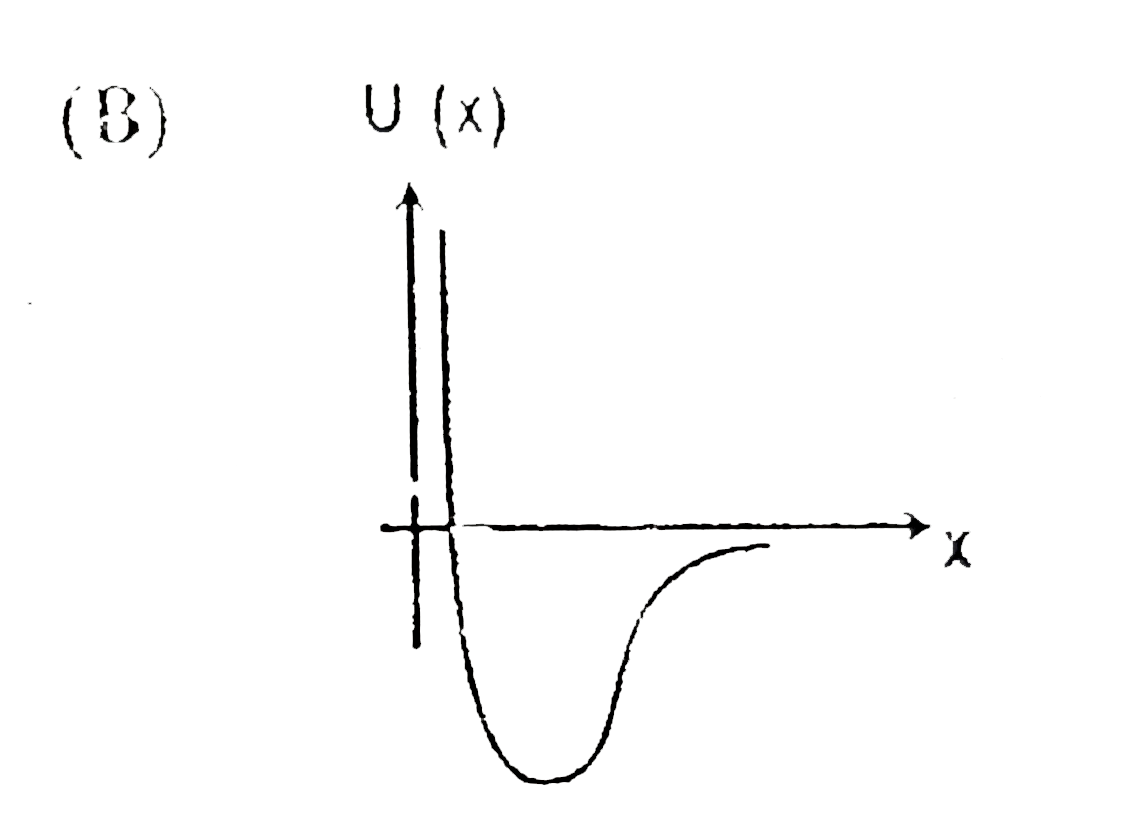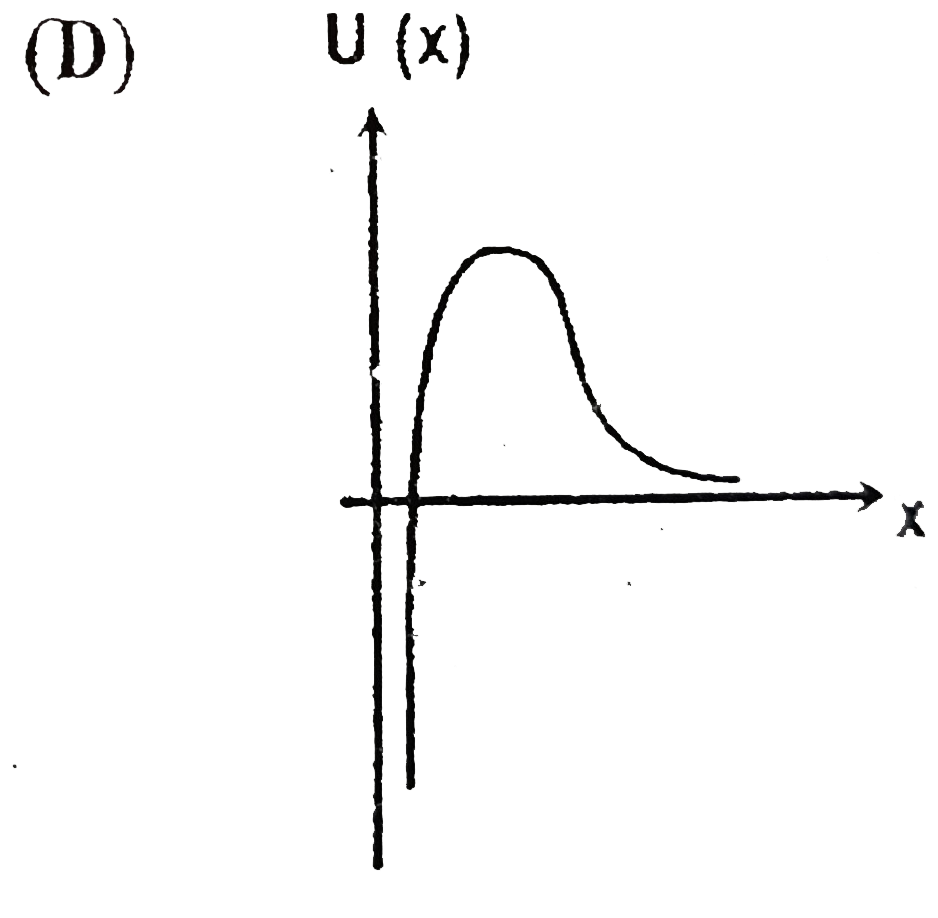The potential energy function for the force between two in a diatomic molecule can approximately be expressed as U(x)=ax12−bx4, where a and b are positive constants, and x is the distance between the atoms. Answer the following question by selecting most appropriate alternative.
The graph between potential energy vs x will be




To analyze the potential energy function U(x)=ax12−bx4 for a diatomic molecule, we will follow these steps:
Step 1: Analyze the behavior of U(x) as x approaches 0 and infinity
- As x→0:
- The term ax12 dominates and approaches +∞.
- Therefore, U(x)→+∞.
- As x→∞:
- The term bx4 approaches 0.
- Therefore, U(x)→0.
Step 2: Find critical points by differentiating U(x)
- Differentiate U(x) with respect to x:
dUdx=−12ax13+4bx5
- Set the derivative equal to zero to find critical points:
−12ax13+4bx5=0
Rearranging gives:
4bx5=12ax13
Multiplying both sides by x13:
4bx8=12a
Simplifying gives:
x8=3ab
Therefore:
x=(3ab)18
Step 3: Determine the nature of the critical points
- To determine whether this critical point is a minimum or maximum, we can analyze the second derivative:
d2Udx2=156ax14+20bx6
- Since both terms are positive for x>0, the second derivative is positive, indicating that the critical point is a minimum.
Step 4: Sketch the graph of U(x)
- The graph of U(x) will start at +∞ when x→0, decrease to a minimum at x=(3ab)18, and then approach 0 as x \to \infty \.
Conclusion
The graph of potential energy U(x) vs.distance x willstartfrom +\infty ,decreasetoaminimum,andthenapproach0as x increases. Therefore, the correct option is that the graph will have a shape that starts high, dips down to a minimum, and then levels off towards zero.
- As x→0:
- The term ax12 dominates and approaches +∞.
- Therefore, U(x)→+∞.
- The term bx4 approaches 0.
- Therefore, U(x)→0.
- Differentiate U(x) with respect to x:
dUdx=−12ax13+4bx5
- Set the derivative equal to zero to find critical points:
−12ax13+4bx5=0
Rearranging gives:
4bx5=12ax13
Multiplying both sides by x13:
4bx8=12a
Simplifying gives:
x8=3ab
Therefore:
x=(3ab)18
- To determine whether this critical point is a minimum or maximum, we can analyze the second derivative:
d2Udx2=156ax14+20bx6
- Since both terms are positive for x>0, the second derivative is positive, indicating that the critical point is a minimum.
- The graph of U(x) will start at +∞ when x→0, decrease to a minimum at x=(3ab)18, and then approach 0 as x \to \infty \.
The graph of potential energy U(x) vs.distance x willstartfrom +\infty ,decreasetoaminimum,andthenapproach0as x increases. Therefore, the correct option is that the graph will have a shape that starts high, dips down to a minimum, and then levels off towards zero.
Topper's Solved these Questions
Similar Questions
The potential energy function for the force between two in a diatomic molecule can approximately be expressed as U(x)=ax12−bx4, where a and b are positive constants, and x is the distance between the atoms. Answer the following question by selecting most appropriate alternative.
The graph between force between the atoms [F(x)] vs x will be
View SolutionThe potential energy function for the force between two in a diatomic molecule can approximately be expressed as U(x)=ax12−bx4, where a and b are positive constants, and x is the distance between the atoms. Answer the following question by selecting most appropriate alternative.
The dissociation energy of the molecule is (initially molecule is at rest at equilibrium)
View SolutionThe potential energy function for the force between two atoms in a diatomic molecule is approximately given by U(x)=ax12−bx6 where a and b are constant and x is the distance between the atoms. Find the dissoociation energy of the molecule which is given as D=[U(x−∞)−Uatequilibrium]
View SolutionThe potential energy between two atoms in a molecule is given by U(x)=ax12−bx6, where a and b are positive constants and x is the distance between the atoms. The atom is in stable equilibrium when
View SolutionThe potential energy between two atoms in a molecule is given by
U=ax2−bx2
where a and b are positive constants and x is the distance between the atoms. The atom is in stable equilibrium when x is equal to :−
View SolutionThe potential energy function for a diatomic molecule is U(x)=ax12−bx6. In stable equilibrium, the distance between the particles is .
View SolutionThe potential energy function associated with the force →F=4xyˆi+2x2ˆj is
View SolutionA particle located in one dimensional potential field has potential energy functionU(x)=ax2−bx3, where a and b are positive constants. The position of equilibrium corresponds to x equal to
View SolutionThe potential energy of a particle in a force field is:
U=Ar2−Br,. Where A and B are positive
constants and r is the distance of particle from the centre of the field. For stable equilibrium the distance of the particle is
View SolutionA particle located in a one-dimensional potential field has its potential energy function as U(x)ax4−bx2, where a and b are positive constants. The position of equilibrium x corresponds to
View Solution
